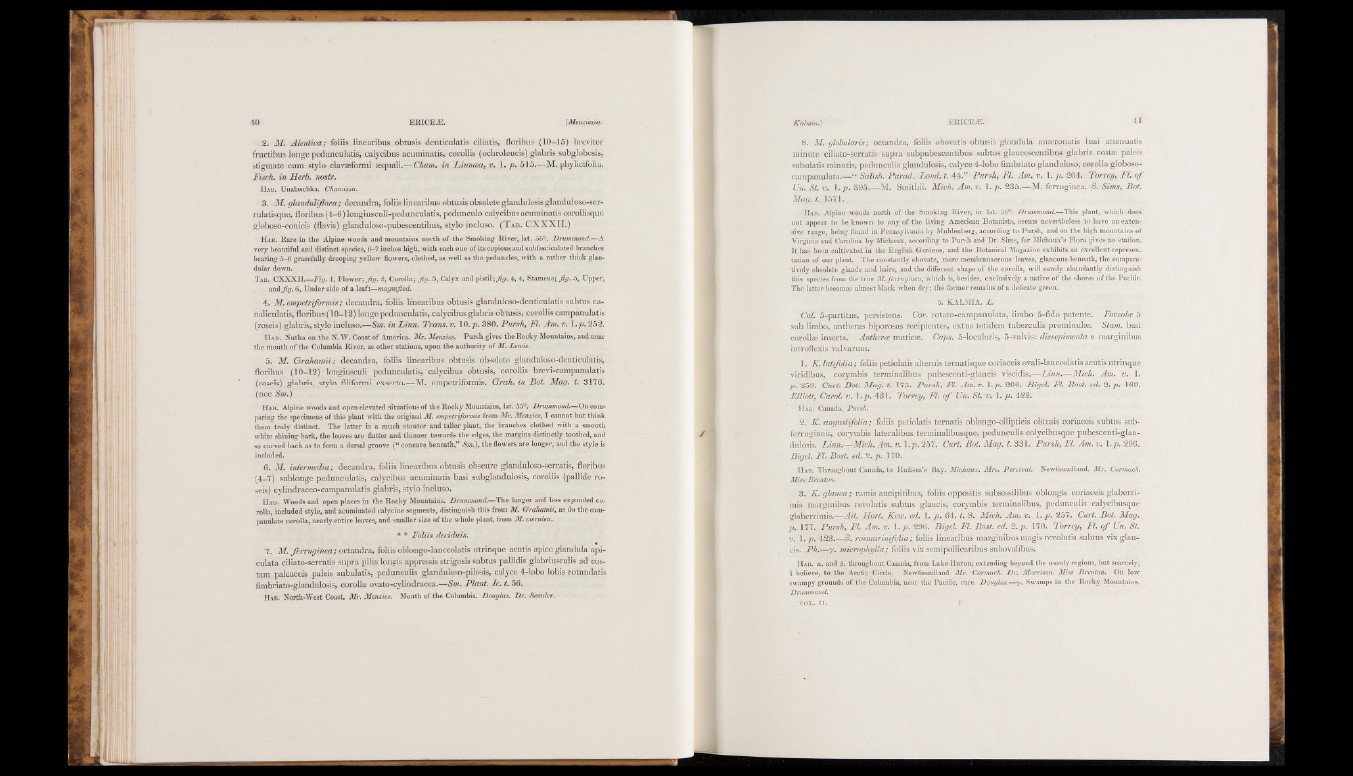
40 ERICE2E. [Menziesiu.
2. M. Aleutica; foliis linearibus obtusis denticulatis ciliatis, floribus (10-15) breviter
fructibus longe pedunculatis, calycibus acuminatis, corollis (ochroleucis) glabris subglobosis,
stigmate cum stylo clavseformi sequali.— Cham, in Linncea, v. 1. p. 515.—M. phylicifolia.
Fisch. in Herb, nostr.
Hab. Unalaschka. Chamisso.
3. M. glanduliflora ; decandra, foliis linearibus obtusis obsolete glandulosis glanduloso-ser-
rulatisque, floribus (4-6) longiusculi-pedunculatis, pedunculo calycibus acuminatis corollisque
globoso-conicis (flavis) glanduloso-pubescentibus, stylo incluso. (T ab. CXXXII.)
Hab. Rare in the Alpine woods and mountains north of the Smoking River, lat. 56°. Drummond.—A
very beautiful and distinct species, 6-7 inches high, with each one of its copious and subfasciculated branches
bearing 5-6 gracefully drooping yellow flowers, clothed, as well as the peduncles, with a rather thick glandular
down.
Tab. CXXXII.—Fig. 1, Flower; fig. 2, Corolla; fig. 3, Calyx and p istil;^. 4, 4, Stamens; fig. 5, Upper,
and fig. 6, Under side of a leaf:—magnified.
4. M. empetriformis; decandra, foliis linearibus obtusis glanduloso-denticulatis subtus ca-
naliculatis, floribus (10-12) longe pedunculatis, calycibus glabris obtusis, corollis campanulatis
(roseis) glabris, stylo incluso.—Sm. in Linn. Trans, v. 10. p. 380. Pursh, FI. Am. v. l.p . 252.
H ab. Nutka on the N. W. Coast of America. Mr. Menzies. Pursh gives the Rocky Mountains, and near
the mouth of the Columbia River, as other stations, upon the authority of M. Lewis.
5. M. Grahamii; decandra, foliis linearibus obtusis obsolete glanduloso-denticulatis,
floribus (10-12) longiusculi pedunculatis, calycibus obtusis, corollis brevi-campanulatis
(roseis) glabris, stylo filiformi exserto.—M. empetriformis. Grah. in Bot. Mag. t. 3176.
(nec Sm.)
Hab. Alpine woods and open elevated situations of the Rocky Mountains, lat. 55°. Drummond.—On comparing
the specimens of this plant with the original M. empetriformis from Mr. Menzies, I cannot but think
them truly distinct. The latter is a much stouter and taller plant, the branches clothed with a smooth
white shining bark, the leaves are flatter and thinner towards the edges, the margins distinctly toothed, and
so curved back as to form a dorsal groove (“ concave beneath,” Sm.), the flowers are longer, and the style is
included,
6. M. intermedia; decandra, foliis linearibus obtusis obscure glanduloso-serratis, floribus
(4-7) sublonge pedunculatis, calycibus acuminatis basi subglandulosis, corollis (pallide roseis)
cylindraceo-campanulatis glabris, stylo incluso.
Hab. Woods and open places in the Rocky Mountains. Drummond.—The longer and less expanded corolla,
included style, and acuminated calycine segments, distinguish this from M. Grahamii, as do the cam-
panulate corolla, nearly entire leaves, and smaller size of the whole plant, from M. casrulea.
* * Foliis deciduis.
7. M. ferruginea; octandra, foliis oblongo-lanceolatis utrinque acutis apice glandula api-
culata ciliato-serratis supra pilis longis appressis strigosis subtus pallidis glabriusculis ad cos-
tam paleaceis paleis subulatis, pedunculis glanduloso-pilosis, calyce 4-lobo lobis rotundatis
fimbriato-glandulosis, corolla ovato-cylindracea.—Sm. Plant. Ic. t. 56.
Hab. North-West Coast. Mr. Menzies. Mouth of the Columbia. Douglas. Dr. Scouler.
Kalmia.] ERICE./E.
8. M. globularis; octandra, foliis obovatis obtusis glandula mucronatis basi attenuatis
minute ciliato-serratis supra subpubescentibus subtus glaucescentibus glabris costas paleis
subulatis minutis, pedunculis glandulosis, calyce 4-lobo fimbriato glanduloso, corolla globoso-
campanulata.— “ Salisb. Par ad. Lond-. t. 44.v Pursh, FI. Am. v. 1. p. 264. Torrey, FI. of
Un. St. v. 1. p. 395.—M. Smithii. Mich. Am. v. l.p . 235.—M. ferruginea, wm Sims, Bot.
Mag. t. 1571.
Hab. Alpine- woods north of the Smoking River, in lat. 56°. Drummond.—This plant, which does
not appear to be known to any of the living American Botanists, seems nevertheless to have an extensive
rano-e, bein'»1 found in Pennsylvania by Muhlenberg, according to Pui^h, and on the high mountains of
Virginia and Carolina by Michaux, according to Pursh and Dr. Sims, for Michaux’s Flora gives no station.
It has been cultivated in the English Gardens, and the Botanical Magazine exhibits an excellent representation
of our plant. The constantly obovate, more membranaceous leaves, glaucous beneath, the comparatively
obsolete glands and hairs, and the different shape of the corolla, will surely abundantly distinguish
this species from the true M. ferruginea, which is, besides, exclusively a native of the shores of the Pacific.
The latter becomes almost black when dry; the former remains of a delicate green.
' ' 5. KALMIA. L.
Cal. 5-partitus, persistens. Cor. rotato-campanulata, limbo 5-fido patente. Foveolce 5
sub limbo, antheras biporosas recipientes, extus totidem tuberculis prominulas. Siam, basi
corollse inserta. Antherce muticse. Caps. 5-locularis, 5-valvis: dissepimehta e marginibus
introflexis valvarum.
]. K. latifolia; foliis petiolatis alternis ternatisque coriaceis ovali-lanceolatis acutis utrinque
viridibus, corymbis terminalibus pubescenti-glaucis viscidis.-—Linn.—Mich. Am. v. 1.
p. 258. Curt. Bot. Mag. t. 175. Pursh, FI. Am.v. l.p . 296. Bigel. FI. Bost. ed. 2 .p. 169.
Elliott, Carol, v. l.p . 431. Torrey, FI. of Un. St. v. 1. p. 422.
Hab. Canada. Pursh.
2. K. angustifolia; foliis petiolatis ternatis oblongo-ellipticis obtusis coriaceis subtus sub-
ferrugineis, corymbis lateralibus terminalibusque, pedunculis calycibusque pubescenti-glan-
dulosis. Linn.—Mich. Am. v. l.p . 257. Curt. Bot. Mag. t. 331. Pursh, FI. Am.v. l.p . 296.
Bigel. FI. Bost. ed. 2. p. 170.
H ab. Throughout Canada, to Hudson’s Bay. Michaux. Mrs. Percival. Newfoundland. Mr. Cormach.
Miss Brenton.
3. K. glauca; ramis ancipitibus, foliis oppositis subsessilibus oblongis coriaceis glaberri-
mis marginibus revolutis subtus glaucis, corymbis terminalibus, pedunculis calycibusque
glaberrimis.—Ait. Hort. Kew. ed. 1. p. 64. t. 8. Mich. Am. v. 1. p. 257. Curt. Bot. Mag.
p. 177. Pursh, FI. Am. v. 1. p. 296. Bigel. FI. Bost. ed. 2. p. 170. Torrey, FI. of Un. St.
v. 1. p. 423.—jS. rosmarinifolia; foliis linearibus marginibus magis revolutis subtus vix glaucis.
Ph.—y. microphylla; foliis vix semipollicaribus subovalibus.
Hab. ec. and /3. throughout Canada, from Lake Huron, extending beyond the woody regions, but scarcely,
I believe, to the Arctic Circle. Newfoundland. Mr. Cormack. Dr. Morrison. Miss Brenton. On low
swampy grounds of the Columbia, near the Pacific, rare. Douglas.—y. Swamps in the Rocky Mountains.
Drummond.